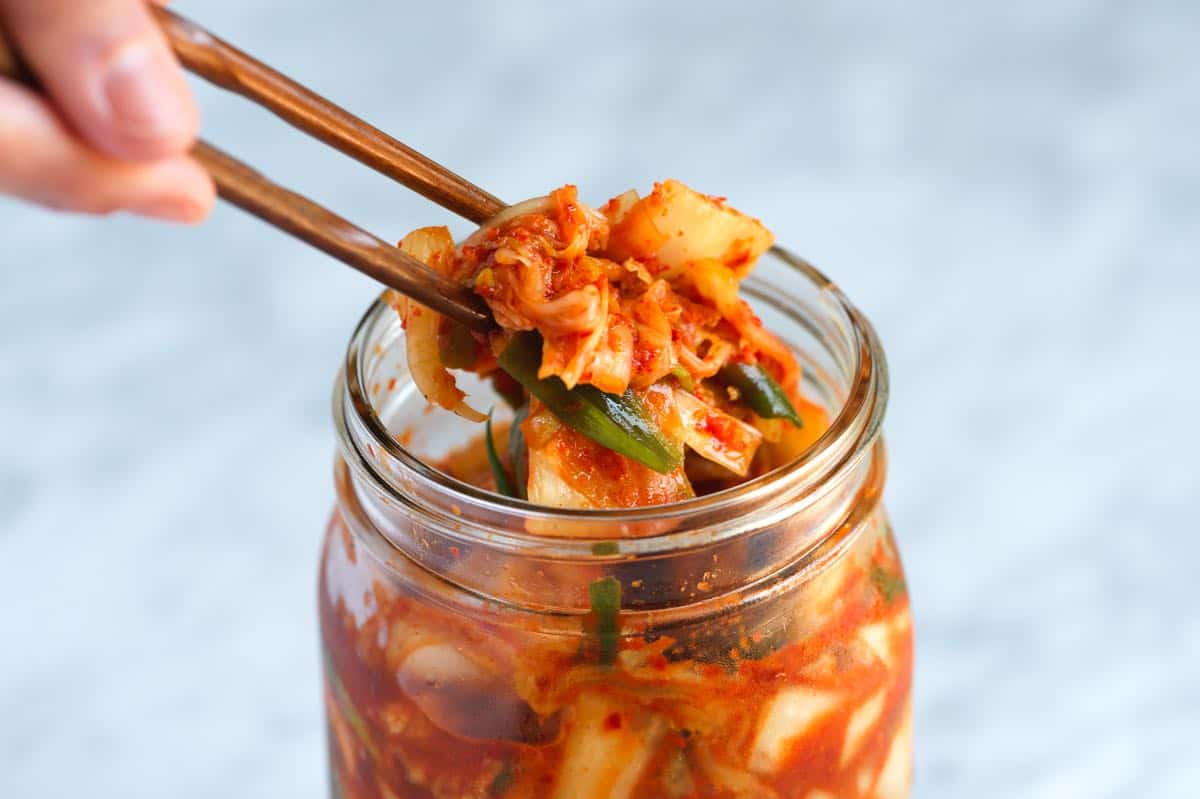
Easy Kimchi
- PREP 2hrs 30min
- TOTAL 2hrs 30min
Our kimchi recipe is beginner friendly. It’s straightforward and can be adjusted to your preferred spice level, depending on how much gochugaru (red chili powder) you use. While some recipes leave the cabbage in wedges, we chop ours into bite-size pieces. This simplifies things and saves a bit of time during the salt brine. We typically make cabbage-only kimchi and don’t add other vegetables (except garlic, ginger, and green onion), but feel free to add shredded Korean radish, daikon, or carrots.
You Will Need
Kimchi Ingredients
1 napa cabbage, about 3 pounds
2 ½ tablespoons (42g) fine sea salt
12 green onions
2 tablespoons rice thickener, recipe below
5 tablespoons (45g) gochugaru, Korean red chili pepper powder
8 cloves garlic, finely grated
One 2-inch knob fresh ginger, finely grated
2 tablespoons fish sauce
4 teaspoons sugar
2 tablespoons water
Rice thickener
1 tablespoon sweet rice flour
1/2 cup (118ml) cold water
Directions
Prepare the cabbage by cutting it in half lengthwise, removing the core, and slicing it into 1 ½-inch pieces. Trim the root ends of the green onions, slice them in half lengthwise, and cut them into 2-inch pieces.
Place the cabbage and green onions in a large bowl (or two bowls if needed). Sprinkle with salt and toss well to combine. Cover with a clean dish towel and let sit at room temperature until the cabbage wilts noticeably, about 1 to 2 hours. After 30 minutes, toss the cabbage to redistribute the salt.
While the cabbage wilts, make the rice thickener by combining 1 tablespoon of rice flour and 1/2 cup of water in a small saucepan. Cook over medium heat, stirring constantly, until it forms a thick paste. Remove from heat and let cool.
Make the chili paste by combining the gochugaru, garlic, ginger, fish sauce, sugar, and water. Add 2 tablespoons of the cooled rice thickener and stir until well blended. Store in the fridge until the cabbage is ready.
Once the cabbage is wilted, rinse it well under cold water (2 to 3 times) and set it aside to drain for 20 to 30 minutes (or use a salad spinner).
Massage the chili paste into the drained cabbage (consider using gloves). Continue until all the cabbage is thoroughly coated.
Pack the kimchi into a 1-quart jar (use a second jar or a smaller 16-ounce jar if you have extra). Press down on the kimchi until the brine covers the cabbage, leaving at least 1 inch of space between the kimchi and the lid. Place a fermentation weight on top if you have one, and seal the jar.
Place the kimchi in the refrigerator to ferment. After a day, “burp” it by pressing down on the cabbage with a clean spoon to release trapped air bubbles
Enjoy your kimchi at any point! It will develop funky, sour notes after a week or two. As it ferments, you might see bubbles forming and brine seeping out of the jar, so consider placing the jar inside a small bowl to catch anything.
Adam and Joanne's Tips
- Vegetarian or Vegan kimchi: Leave out the fish sauce and add 1 to 2 tablespoons of white or red miso paste to the chili powder mixture before massaging it into the cabbage.
- Salt: Use iodine-free salt. Iodine can prevent proper fermentation.
- Gochugaru: Korean red chili powder or flakes add heat, flavor, and vibrant red color to kimchi. We used Mother In Law’s Gochugaru in our photos since it is commonly available in local grocery stores. You can also find Gochugaru sold in International/Korean markets. If you have the choice between hot or mild, choose mild since you can add more and make your kimchi more vibrant without making it too spicy (tip from Maangchi).
- Spicy kimchi: Increase the gochugaru in the recipe or use gochugaru that’s labeled medium or hot to make your batch. You can taste the chili paste as you are making it to see if it is spicy.
- Nutrition facts: The nutrition facts provided below are estimates. We have used the USDA database to calculate approximate values. Note that sodium is difficult to determine with this recipe.